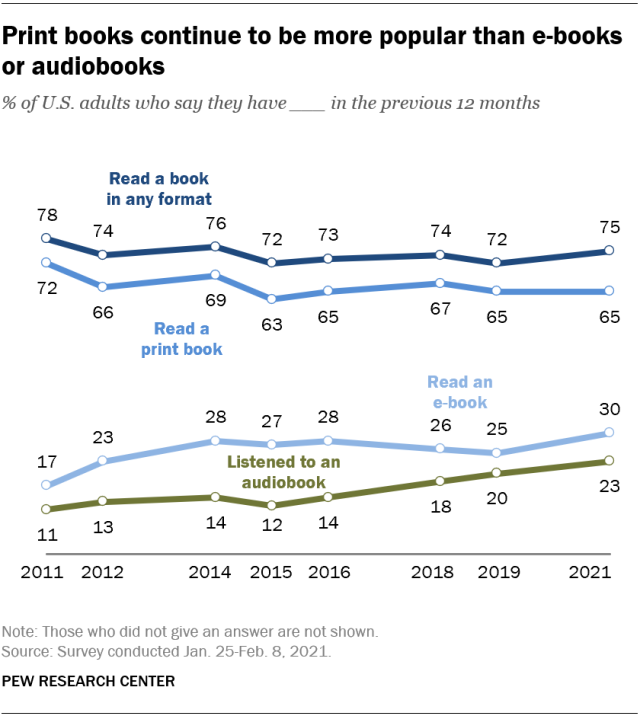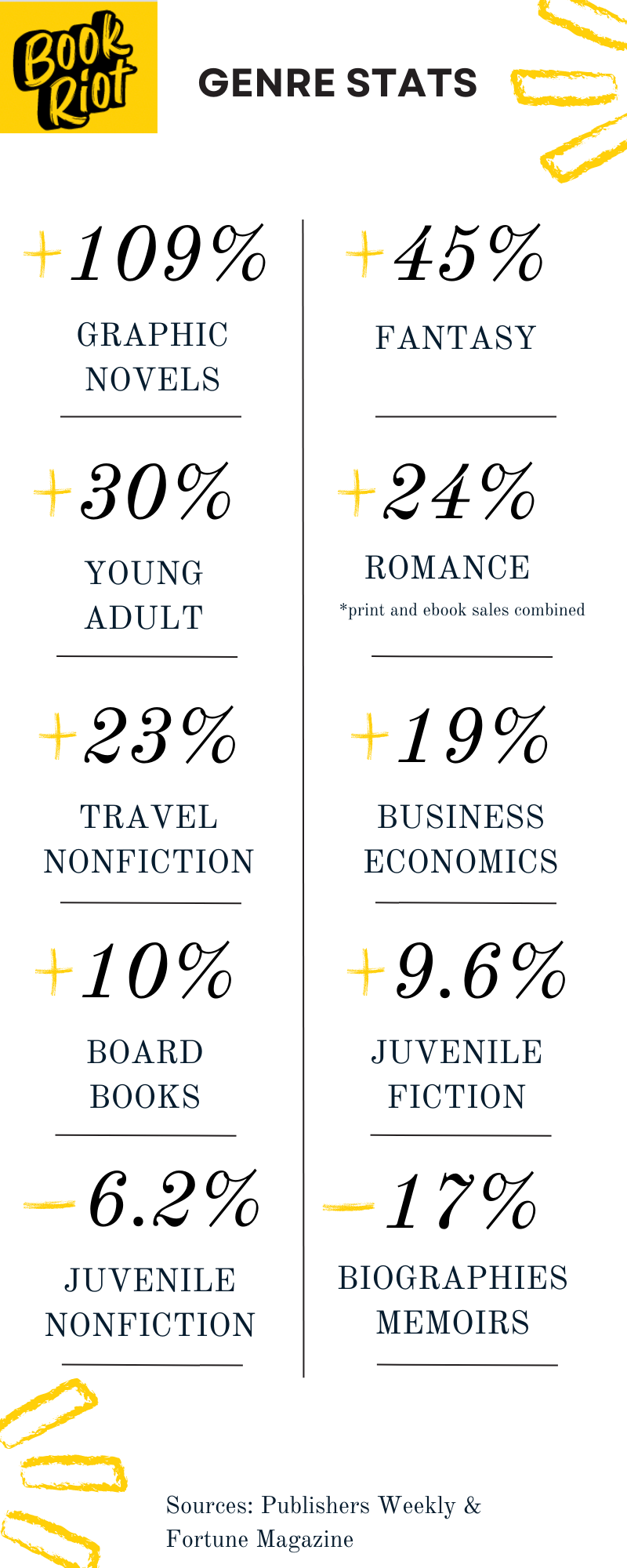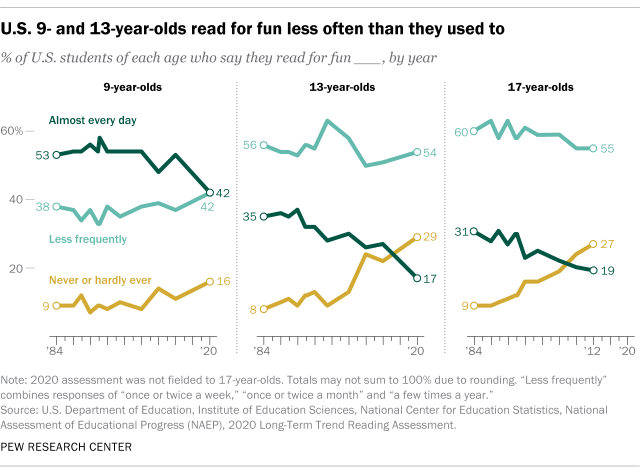Our last review of reader statistics was done in 2019. It’s time we took the pulse of readership in the U.S. and see how it compares to the rest of the world, especially in light of the pandemic. Paying attention to how often and what we’re reading can be a surprisingly illuminating venture. It shows how we’re coping, how we’re trying to enrich our lives, and what is collectively capturing our attention. We’re also going to take a look at how reading habits and fluency have changed with kids, and take a peek at how publishing sales have been doing since the start of the pandemic. I hope you’re ready for some charts and graphs, because that’s where we’re headed. The overall message that these book stats deliver is a positive one, even if it may not seem to be on the surface, and for the statistics that are less than encouraging, remember: the reason we collect this data is to see where the gaps are, and where we can do better. The PEW Research Center conducted a survey in January–February of 2021 and found that 23% of adults in the U.S. have not read a book in whole or in part in the previous year, although this number has held relatively steady since 2014. The demographic traits linked to this slice of the population include adults who hold a high school diploma or less (39%) versus adults with a Bachelor’s or advanced degree (11%). Adults whose household income is less than $30,000 are less likely to be avid readers than adults with a household income of $75,000 or more (31% vs. 15%, respectively). The median number of books Americans read in the last years was five. The average, on the other hand, was about 14 books. Adults who live in urban areas saw a 6% increase in reading, from 75% in 2019 to 81% in 2021. Those who identify as men were more likely to have not read a book in the last year than those who identify as women (26% vs. 21%). Adults over 50 were the largest age demographic to have not read a book, at 28%. Community types also play a role: 29% of adults in rural areas reported not reading a book in the last year, vs. 25% of suburban adults, vs. 18% of urban adults.
International Reading Statistics Comparisons
The NOP World Culture Score Index has not updated its stats for which country reads the most since we reported the results in 2019 (with India, Thailand, and China taking the top three spots and the U.S. tying with Germany in the 22nd spot). World literacy rates have not been updated since 2019, which is also understandable. The last reported global literacy rate from the World Population Review was at 86.3%, with men’s literacy rate at 90% and women’s at 82.7%. China Daily released the results of the Chinese Academy of Press and Publication’s 2020 annual report on Chinese people’s reading habits, and found that 81% of Chinese adults have a habit of reading. In 2019, Chinese adults read a little over four print books a year and two ebooks a year. BookNet Canada reported an increase in Canadian readership from 66% at the end of 2019 to 73% by mid 2020. The majority of Canadian readers indicated that they read for pleasure (76%) and to gain knowledge or improve skills (40%). The Guardian reported that UK book sales were the highest in 2021 than they’ve been in a decade, with crime, sci-fi, fantasy, romance, and personal development leading the sales figures. The New Indian Express reported that reading time in India nearly doubled: from nine hours a week to 16 hours a week in 2020. The most popular genres among Indian readers in 2020 were YA, and a lot of nonfiction, particularly historical/political biographies and self-help/personal development.
Book Statistics: Sales and Genres
Publishers Weekly reported an 8.9% increase in print book sales in 2021 from the previous year. U.S. publishers sold 825.7 million print books, up from 757.9 million in 2020. This is a pretty positive upward trend, because 2020 also saw an 8.2% increase in unit sales over 2019. So what genres are people reading in the U.S.? Graphic novels and fantasy dominated in 2021, with graphic novels increasing their sales by a whopping 109% and fantasy sales up by 45% from the previous year. YA sales also soared over 30% from 2020. Adult fiction sales rose overall by 25%, with the majority of those increases coming from fantasy and romance (up 24% from 2020 from both print and ebooks sales combined). Juvenile fiction sales rose by 9.6%, but juvenile nonfiction decreased by 6.2%, whereas in 2020 this genre enjoyed a 23% boost. Some other surprises came from the adult nonfiction space. Travel nonfiction saw a boost with a 23% gain, which is a remarkable recovery from 2020, where travel nonfiction sales plummeted by 40% from the previous year. I think it’s a safe bet to say that the urge to travel has revived in the last year. Business/economics nonfiction also rose by 19%. Biographies, autobiographies, and memoirs dropped quite a bit, with sales decreasing by 17% compared to 2020. And finally, board books rose 10% in sales from the previous year. Although the book statistics for other sub-genres of adult fiction were not as easy to find, we learned a lot from you about your reading habits through various surveys. The Conversation conducted a survey in late 2020 to see what people were reading, and found that rereads of already familiar, well-loved books were a popular pastime. Horror also spiked in popularity in 2020, as well as antiracism and social justice nonfiction. Survey respondents also indicated that although they were reading more often, they were not necessarily reading more books; their reading progression had merely slowed. Parents also reported more reading time, but they were reading to their children and had less time for personal reading. We also conducted a pandemic reading habits survey in July of 2021. The top adult fiction genres that are doing well among readers include romance, fantasy, mystery, science fiction, and light fiction. Four in ten 9-year-olds (42%) say they read every day for fun, down 53% from 2012. Only 17% of 13-year-olds said they read for fun every day, down from 27% in 2012. Children’s reading fluency has also taken a dip due to the pandemic, particularly among second and third graders. Researchers at the Stanford Graduate School of Education conducted a reading assessment study in early 2021 among 1st through 4th graders in over one hundred school districts across the U.S. They found that oral reading fluency fell behind in the spring of 2020, so much so that the gains in fall of 2020 couldn’t make up for it. Historically, the trajectory for reading fluency had been steadily rising; in 2020, the trajectory flattened. Second and 3rd graders are roughly 30% behind in their overall reading fluency skills. It’s important to note that growth did occur in the fall semester of 2020, and that the impact was inequitable; school districts that serve low-income communities report slower reading skill development, and these students are most likely dealing with additional hardship that may include a lack of reliable internet and/or computer access at home for remote learning. Overall, the data we’re receiving since the start of the pandemic has shown that we are collectively turning to books for escapism, stress relief, and self-improvement. It also shows how hard our kids and teachers have been working to help give kids the support they need as they’ve grappled with unprecedented obstacles. For more data, check out Kelly Jensen’s bookish research from last July and Rebecca Hussey’s research from January on ebook readership.


